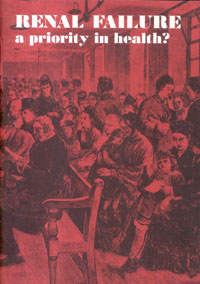Unlocking the Value of Combination Therapies

The incidence of treatable chronic renal failure in Britain and other Western countries is very small indeed. The most commonly quoted figure is forty people (under sixty years old) per million total population per year.1 Compared with conditions like coronary heart disease, cancer,…
The incidence of treatable chronic renal failure in Britain and other Western countries is very small indeed. The most commonly quoted figure is forty people (under sixty years old) per million total population per year.1 Compared with conditions like coronary heart disease, cancer, bronchitis or arthritis, therefore, the magnitude of renal failure as a current health problem appears insignificant. What makes renal failure important, both in itself and as an illustration of the problems the NHS may have to face increasingly in the future, is the existence of an undoubtedly life-saving but at the same time highly expensive treatment in the form of dialysis and/or transplantation.
Up until the nineteen-thirties there were few areas where medical intervention could be claimed to be effective in saving life. Since the therapeutic revolution the capacity to intervene productively has increased enormously but in most cases prevention or treatment has involved chemotherapy. Usually this is relatively inexpensive, easy to procure (by prescription) and, in effect, freely available under the NHS. Dialysis and transplantation, on the other hand, like other forms of treatment requiring expensive hardware and ancillary staff, are relatively costly. It is also less easy to set up extra dialysis facilities than it is to make out another prescription or to perform a simple surgical operation. As a result, the availability of treatment for renal failure has been restricted and particularly difficult decisions have to be made by health service practitioners who come face to face with prospective patients.
Following the 1978 budget, in which provision was made for 400 extra dialysis machines, it may be anticipated that between twenty and twenty-five new patients per million population will be accepted for treatment in Britain. This implies that between fifteen and twenty million, about 750 to 1,000 people (under 60 years old) will not be accepted and will, presumably, die.
There are, of course, other areas of the NHS, apart from dialysis and transplantation, where effective intervention is not available to all those likely to benefit. For example, a screening programme for high blood pressure among middle-aged men, followed by treatment, could significantly reduce mortality and incapacity from strokes. Another example is the replacement of arthritic joints. Patients may have to wait several years for treatment under the NHS.
So far, however, dialysis and transplantation is the only area of activity of the NHS (apart, perhaps, from accident and emergency services) where shortages of money and equipment (as well as kidneys for transplantation) prevent medical practitioners from extending routine life-saving treatment to otherwise fit individuals who present with a terminal condition. It is for this reason that discussion of the subject is often so emotionally charged. Despite this, any sensible debate must accept, as a point of departure, that no service has an absolute claim on resources. If one service is given more money then, in principle, sacrifices have to be made elsewhere – either inside or outside the NHS.
Laing, W.
(1978) Renal Failure a priority in health?. OHE Series on Health. Available from https://www.ohe.org/publications/renal-failure-priority-health/